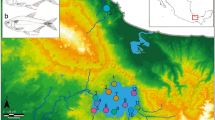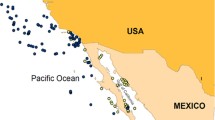Abstract
Lineus ruber and L. viridis are common intertidal heteronemerteans found on the coasts of northern Europe and the east coast of North America. The two species resemble each other morphologically and were synonymised for many years prior to being separated on the basis of larval development. In this study, specimens of L. ruber and L. viridis were collected from sites along the west and southwest coast of Britain, northern France and the east coast of North America. The external morphology and allele frequencies of isozymes of the two species were compared from all sites. The external morphology of L. ruber and L. viridis was similar but they could generally be separated by colour. Allele frequencies for up to 13 enzyme loci between sympatric populations of L. ruber and L. viridis indicated that these two species are genetically very different (Nei's genetic identity=0.090 to 0.083). Allele-frequency data also indicated the presence of a third genetic type occurring sympatrically with populations of both L. ruber and L. viridis on the coasts of Britain and France but not on the coast of North America. Fixed differences in allele frequencies between populations of the third genetic type and sympatric populations of L. ruber and L. viridis were observed across multiple loci. Genetic identity between the third genetic type and sympatric populations of L. ruber and L. viridis were extremely low (Nei's genetic identity =<0.078). Such large genetic differences between populations indicate a barrier to gene flow and reproductive isolation. The aberrant type, which exhibits sufficient morphological variation to prevent individuals being distinguished from those of both L. ruber and L. viridis, therefore represents a separate species. The low genetic identities found in intrageneric comparisons of species found in this study have been found in other studies on nemerteans. They may indicate systematic problems within these groups or other phenomena such as morphological stasis.
Similar content being viewed by others
References
Arnold G (1898) Zur Entwicklungsgeschichte des Lineus gesserensis O.F. Müller (L. obscurus Barrois). Trudū imp S-peterb Obshch Estest 28:21–30
Ayala FJ (1975) Genetic differentiation during the speciation process. In: Dobzhanskv T, Hecht MK, Steere WC (eds) Evolutionary biology Vol. 8. Plenum Press, New York, pp 1–78
Ayala FJ (1983) Enzymes as taxonomic characters. In: Oxford GS, Rollinson D (eds) Protein polymorphism: adaptive and taxonomic significance. Academic Press, London, pp 3–26
Balakirev ES, Manchenko GP (1984) Vnutrividovaya geneticheskaya izmenchivost belkov u nemertinui Lineus torquatus. Genetika 20:2070–2071
Barrois J (1877) Mémoire sur l'embryologie des Némertes. Annls Sci nat (sér Zool) 6 (No. 3):1–232
Bierne J (1962) La régénération de la trompe ches les Némertes. Bull biol Fr Belg 96:481–504
Bierne J (1964) Maturation sexuelle anticipée par décapitation de la femelle chez l'hétéronémerte Lineus ruber Müller. C r hebd Séanc Acad Sci, Paris 259:4841–4843
Bierne J (1966) Localisation dans les ganglions cérébroïdes du centre régulateur de la maturation sexuelle chez la femelle de Lineus ruber Müller (Hétéronémertes). C r hebd Séanc Acad Sci, Paris 263:1572–1575
Bierne J (1970a) Influence des facteurs hormonaux gonado-inhibiteur et androgène sur la differentiation sexuelle des parabionts hétérosexués chez un némertian. Année biol 9:395–400
Bierne J (1970b) Recherches sur la différenciation sexuelle au cours de l'ontogenèse et de la régénération chez le némertien Lineus ruber (Müller). Annls Sci nat (sér Zool). 12:181–298
Bierne J (1970c) Aspects expérimentaux de la différenciation sexuelle chez Lineus ruber (Hétéronémertes). Bull Soc zool Fr 95:529–543
Bierne J (1979) Viable animals obtained by grafting pieces from several nemertean adults. Transplantation 29:74–75
Bierne J (1983) Nemertina. In: Adiyodi KG, Adiyodi RG (eds) Reproductive biology of the Invertebrates. Vol. 1. Oogenesis, oviposition and oosorption. John Wiley & Sons Ltd, London, pp 147–167
Brunberg L (1964) On the nemertean fauna of Danish waters. Ophelia 1 (1):77–111
Corrêa DD (1963) Nemerteans from Curaçao. Stud Fauna Curaçao 17:41–56
Ferguson A (1980) Biochemical systematics and evolution. Blackie & Son, Glasgow
Fisher FM, Cramer NM (1967) New observations on the feeding mechanism in Lineus ruber (Rhynchocoela). Biol Bull mar biol Lab, Woods Hole 132:p 464
Fisher FM, Oaks JA (1978) Evidence for a nonintestinal nutritional mechanism in the rhynchocoelan, Lineus ruber. Biol Bull mar biol Lab, Woods Hole 154:213–225
Fisher RA (1935) The logic of inductive inference. Jl R statist Soc 98:39–54
Franzén Å (1983) Nemertina. In: Adiyodi KG, Adiyodi RG (eds) Reproductive biology of invertebrates. Vol. II Spermatogenesis and sperm function. John Wiley & Sons Ltd, London, pp 159–170
Friedrich H (1935) Studien zur Morphologie, Systematik and Ökologie der Nemertinen der Kieler Bucht. Arch Naturgesch 4:293–375
Gibson R (1982) British nemerteans. In: Kermack DM, Barnes RSK (eds) Synopses of the British fauna. Cambridge University Press, Cambridge, pp 1–212
Gibson R (1995) Nemertean genera and species of the world: an annotated checklist of original names and description citations, synonyms, current taxonomic status, habitats and recorded zoogeographic distribution. J nat Hist (in press)
Gontcharoff M (1951) Biologie de la régénération et de la reproduction chez quelques Lineidae de France. Annls Sci nat (sér Zool) 13:149–235
Gontcharoff M (1957) Étude des rhabdites de la trompe de Lineus ruber (némertien) au microscope électronique. C r hebd Séanc Acad Sci Paris 244:1539–1541
Gontcharoff M (1960) Le développement post-embryonnaire et la croissance chez Lineus ruber et Lineus viridis (Némertes Lineidae). Annls Sci nat (sér Zool) 2:225–279
Harris H, Hopkinson DA (1978; and subsequent supplements) Handbook of enzyme electrophoresis in human genetics. North Holland Publishing Co., Amsterdam
Hubrecht AAW (1886) Contributions to the embryology of the Nemertea. Q Jl microsc Sci 26:417–448
Jennings JB (1962) A histochemical study of digestion and digestive enzymes in the rhychocoelan Lineus ruber (O.F. Müller) Biol Bull mar biol Lab, Woods Hole 136:405–433
Jennings JB, Gibson R (1969) Observations on the nutrition of seven species of rhychocoelan worms. Biol Bull mar biol Lab, Woods Hole 136:405–433
Kimura M (1983) The neutral theory of molecular evolution. Cambridge University Press, Cambridge
Lechenault H (1965) Neurosécrétion et osmorégulation chez les Lineidae (Hétéronémertes). C r hebd Séanc Acad Sci Paris 261:4868–4871
Lessios HA (1992) Testing electrophoretic data for agreement with Hardy-Weinberg expectations. Mar Biol 112:517–523
Ling EA (1969) The structure and function of the cephalic organ of the nemertine Lineus ruber. Tissue Cell 1:503–524
Ling EA (1970) The structure and function of the cephalic organs of the nemertine (Lineus ruber and Amphiporus lactifloreus). Ph.D. thesis. University of Cambridge, Cambridge, UK
Ling EA (1971) The proboscis apparatus of the nemertine Lineus ruber. Phil Trans R Soc (Ser B) 262:1–22
Mayr E (1957) Species concepts and definitions, in the species problem. Publs Am Ass Advmt Sci 1–22
Mayr E (1963) Animal species and evolution. Harvard University Press, Cambridge, USA
McDermott JJ, Roe P (1985) Food, feeding behaviour and feeding ecology of nemerteans. Am Zool 25:113–125
Marphy RW, Sites JW, Buth DG, Haufler CH (1990) Proteins. I. Isozyme electrophoresis. In: Hillis DM, Moritz C (eds) Molecular systematic. Sinauer Associates, Inc. Sunderland, Mass, USA pp 45–126
Nei M (1972) Genetic distance between populations. Am Nat 106:283–292
Nei M (1978) Estimation of average heterozygosity and genetic distance from a small number of individuals. Genetics, Austin, Tex 89:583–590
Nei M (1987) Molecular evolutionary genetics. Columbia University Press, New York
Nevo E (1978) Genetic variation in natural populations: patterns and theory. Theor Popul Biol 13:121–177
Nevo E, Beiles A, Ben-Schlomo R (1984) The evolutionary significance of genetic diversity: ecological demographic and life-history correlates. In: Mani GS (ed) Evolutionary dynamics of genetic diversity. Springer-Verlag, Heidelberg, pp 13–212
Nordhausen W (1988) Impact of the nemertean Lineus viridis on its polychaete prey on an intertidal sand flat. Hydrobiologia 156:39–46
Nusbaum J, Oxner M (1910) Studien über die Regeneration der Nemertinen. I. Regeneration bei Lineus ruber (Müll). Arch EntwMech Org 30:74–132
Nusbaum J, Oxner M (1911) Weitere Studien über die Regeneration der Nemertien. I. Regeneration bei Lineus ruber Müll. Arch EntwMech Org 32:349–396
Nusbaum J, Oxner M (1913) Die Embryonalentwicklung des Lineus ruber Müll. Ein Beitrag zur Entwicklungsgeschichte der Nemertinen. Zwiss Zool 107:78–197
Richardson BJ, Baverstock PM, Adams M (1986) Allozyme electrophoresis. Academic Press, Sydney
Riser NP (1974) Nemertinae. In: Giese AC, Pearse JS (eds) Reproduction of marine invertebrates. Vol. 1. Acoelomate and pseudocoelomate metazoans. Academic Press, New York and London, pp 359–389
Rogers AD (1993) Aspects of the genetics and taxonomy of marine nemerteans. Ph.D. thesis. University of Liverpool
Rogers AD, Junoy J, Gibson R, Thorpe JP (1993) Enzyme electrophoresis, genetic identity and description of a new genus and species of heteronemertean (Nemertea, Anopla) from northwestern Spain and North Wales. Hydrobiologia 266:219–238
Schmidt GA (1934) Ein zweiter Entwicklungstypus von Lineus gesserensis-ruber O.F. Müller. (Nemertini). Zool Jber Neapel 58:607–660
Schmidt GA (1946) Genetic and ecological relations of littoral nemerteans of the genus Lineus. Dokl Acad Nauk SSSR 51:405–407
Scozzani R, Ulizzi A, Ferracin A, Lunadei M (1980) An electrophoretic polymorphism in Triturus cristatus carnifex (Amphibia, Urodela). Experientia 36:p 645
Selander RK (1977) Genic variation in natural populations. In: Ayala FJ (ed) Molecular evolution. Sinauer Associates Incorporated, Sunderland, Mass, pp 21–45
Solé-Cava AM, Boury-Esnault N, Vacelet J, Thorpe JP (1992) Biochemical genetic divergence and systematics in sponges of the genera Corticium and Oscarella (Demospongiae: Homoscleromorpha) in the Mediterranean Sea. Mar Biol 113:299–304
Solé-Cava AM, Klautau M, Boury-Esnault N, Borojecic R, Thorpe JP (1991) Genetic evidence for cryptic speciation in allopatric populations of two cosmopolitan species of the calcareous sponge genus Clathrina. Mar Biol 111:381–386
Solé-Cava AM, Thorpe JP (1990) High levels of genetic variation in marine sponges. In: Rutzler K (ed) New perspectives in sponge biology. Smithsonian Institution Press, Washington, pp 332–337
Solé-Cava AM, Thorpe JP (1991) High levels of genetic variation in natural populations of marine lower invertebrates. Biol J Linn Soc 44:65–80
Solé-Cava AM, Thorpe JP, Kaye JG (1985) Reproductive isolation with little genetic divergence between Urticina (=Tealia) felina and U. eques (Anthozoa: Actiniaria). Mar Biol 85:279–284
Sundberg P, Janson K (1988) Polymorphism in Oerstedia dorsalis (Abilgaard, 1806) revisited. Electrophoretic evidence for a species complex. Hydrobiologia 156:93–98
Swofford DL, Selander RB (1989) Biosys-1. A computer program for the analysis of allelic variation in population genetics and biochemical systematics. Release 1.7. Illinois Natural History Survey, Champaign, Illinois
Thiel M, Reise K (1993) Interaction of nemertines and their prey on tidal flats. Neth J Sea Res 31:163–172
Thorpe JP (1982) The molecular clock hypothesis: biochemical evolution, genetic differentiation and systematics. A Rev Ecol Syst 13:139–168
Thorpe JP (1983) Enzyme variation, genetic distance and evolutionary divergence in relation to levels of taxonomic separation. In: Oxford GS, Rollinson D (eds) Protein polymorphism: adaptive and taxonomic significance. Academic Press, London pp 131–152
Thorpe JP, Solé-Cava A (1994) The use of allozyme electrophoresis in invertebrate systematics. Zoologica Scr 23:3–18
Vernet G (1966) Les pigments de Lineus ruber (O.F. Müller) (Hétéronémertes Lineidae). C r hebd Séanc Acad Sci Paris 263:191–194
Vernet G (1970) Ultrastructure des photorécepteurs de Lineus ruber (O.F. Müller) (Hétéronémertes Lineidae). I. Ultrastructure de I'oeil normal. Z. Zellforsch mikrosk Anat 104:494–506
Vernet G (1992) Localisation du réflexe lucifuge dans les ganglions cérébroïdes dorsaux de la némerte marine, Lineus ruber (O.F. Müller): étude expérimentale. Can J Zool 70:750–752
Vernet G, Bierne J (1993) The influence of light and sea water temperature on the reproductive cycle of Lineus ruber (Heterone-mertea). Hydrobiologia 266:267–271
Ward RD, Beardmore JA (1977) Protein variation in the plaice (Pleuronectes platessa). Genet Res 30:45–62
Wake DB, Roth G, Wake MH (1983) On the problem of stasis in organismal evolution. J theor Biol 101:211–224
Williams KA, Skibinski DOF, Gibson R (1983) Isoenzyme differences between three closely related species of Lineus (Heteronemertea). J exp mar Biol Ecol 66:207–211
Willmer EN (1970) Cytology and evolution. 2nd ed. Academic Press, New York and London
Wright S (1951) The genetical structure of populations. Ann Eugen 15:323–354
Wright S (1965) The interpretation of population structure by F-statistics with special regard to systems of mating. Evolution 19: 395–420
Author information
Authors and Affiliations
Additional information
Communicated by J. Mauchline, Oban
Rights and permissions
About this article
Cite this article
Rogers, A.D., Thorpe, J.P. & Gibson, R. Genetic evidence for the occurrence of a cryptic species with the littoral nemerteans Lineus ruber and L. viridis (Nemertea: Anopla). Marine Biology 122, 305–316 (1995). https://doi.org/10.1007/BF00348944
Received:
Accepted:
Issue Date:
DOI: https://doi.org/10.1007/BF00348944




